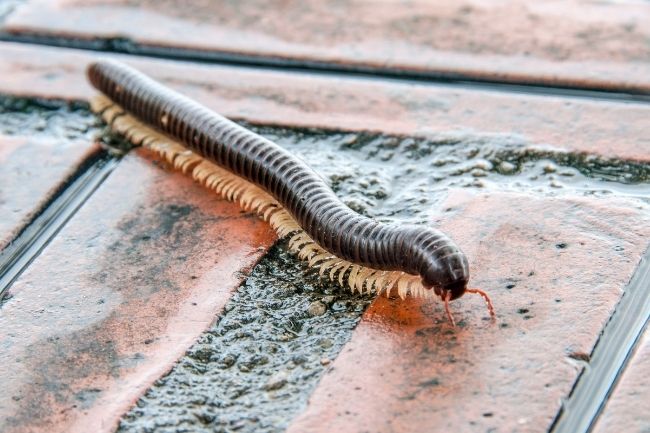A wide variety of animals eat millipedes, given that they are very much at the bottom of the food chain. Predators include hedgehogs, birds, monkeys and frogs, to name a few.
Contents
Millipedes

Across the world there are over 16,000 species of millipedes, ranging from some a few millimetres long, to the largest millipede in the world, the African giant millipede, reaching 33 cm (12.99 in) long.
With such a wide range of species, living in an even wider range of habits, from rainforests to deserts, even to our own houses, it’s not surprising that they have a wide range of predators.
What eats each species depends on many factors, including what they share their space with and what food those creatures specialise in. There are few animals that specifically hunt for millipedes, but many insect-eating animals will consume millipedes when they come across them.
| Animal | Description |
|---|---|
| Eastern Box Turtle | Omnivorous turtle that preys on millipedes among other food sources |
| Virginia Opossum | Opportunistic omnivore that feeds on millipedes when available |
| Ground Beetle | Carnivorous beetle that hunts and consumes millipedes |
| Skunk | Omnivorous mammal that includes millipedes in its diet |
| Red-shouldered Hawk | Raptor that feeds on various small invertebrates, including millipedes |
| Animal | Description |
|---|---|
| European Hedgehog | Insectivorous mammal that consumes millipedes along with other prey |
| European Robin | Small bird that forages on the ground and includes millipedes in its diet |
| European Badger | Omnivorous mammal that occasionally feeds on millipedes |
| Common Toad | Amphibian that preys on various invertebrates, including millipedes |
| Animal | Description |
|---|---|
| Echidna | Monotreme mammal that feeds on a variety of invertebrates, including millipedes |
| Australian Magpie | Opportunistic omnivorous bird that includes millipedes in its diet |
| Blue Tongue Lizard | Large skink that feeds on various invertebrates, including millipedes |
| Eastern Brown Snake | Venomous snake that preys on small invertebrates, including millipedes |
Also read: Millipedes and Centipedes – The Difference Explained
Millipede self-defence

Of course, millipedes don’t really want to be eaten. While millipedes don’t have much to defend themselves with, having no sting or large jaws, they do have a little arsenal to keep themselves safe.
A millipede’s best weapon is simply being unobtrusive. Millipedes spend most of their time in dark, damp places, well out of sight of most other animals. Added to this their colours are often subdued browns, blacks and greys, camouflaging them further into the dark.
When detected, their first defensive move is often to curl up, protecting their legs and body. Their hard exoskeleton adds extra protection from smaller predators.
Finally, most millipedes also produce a toxic substance, that they can extrude from their skin via pores located down their body, when stressed or threatened.
This chemical mixture often smells and tastes unappealing, helping to ward off animals thinking of taking a bite. Poisonous chemicals like cyanide are also often included, making animals that eat them ill, or even leading to death.
The type and strength of these toxic substances vary a great deal between millipedes, and some animals have adapted to be able to withstand this chemical attack, the meaning of even this clever defence isn’t always enough.
Also read: Millipede and its Legs (How Many, Why & Much More)
Hedgehogs
Hedgehogs may look cute and cuddly to us, but to the creepy crawlies, they hunt, they are a veritable Godzilla.
Hedgehogs generally aren’t fussy eaters, though they have a taste for slugs and snails, and will eat most invertebrates they come across. Generally, it will be the smaller species that fall victim to hedgehogs.
Birds
Many birds are insectivores, meaning they eat large insects. While many species of bird would be more than happy to chomp down on a millipede, it’s more likely that birds that spend time turning over rocks or searching through leaves, will find and eat millipedes.
Ants
It may be surprising, but despite ants being much smaller than millipedes, they are often the hunter rather than the hunted.
What ants have in their favour is that they have strength in numbers. While millipedes live a largely solitary life, ants are all about the colony.
Army ants may be the most ferocious hunters of other invertebrates and march through a landscape attacking and killing any insects they find.
Having seen a millipede, they will overpower it and then carry it away to be cut apart and eaten. Certainly, a gruesome way to go.
Scorpions
When it comes to pitting a scorpion against a millipede, it’s hard to imagine the millipede coming out on top.
With their dangerous pincers and vicious stings, scorpions can easily overpower a millipede, turning even larger species into a tasty snack.
Reptiles
While we may think of reptiles as eating larger animals such as small mammals, some lizards and other reptile species, specialise in insects.
For these reptiles, millipedes can be a great snack, though they may not encounter them as often as insects that like to spend their time out on the surface, rather than scurrying around under rocks.
Monkey and millipedes
It’s strange but true that the toxic chemicals that some millipedes exude are actually a natural kind of mosquito repellent. While we may not wish to bathe in millipede juice to prevent a few annoying bites, monkeys aren’t quite as fussy.
Capuchin monkeys have been observed seeking out particular millipede species and rubbing this unfortunate insect all over their fur, passing it around the group. It is thought this behaviour is in order to protect the monkeys from mosquitos and other unpleasant biting insects.
Lemurs and millipedes
Like monkeys, lemurs are thought to use millipedes as a kind of medicine, both for repelling external pests, and also for treating stomach parasites.
However, some scientists also suggest lemurs use millipedes as a kind of intoxicating drug, getting high off the chemicals they exude. Certainly, an unusual use for this many-legged invertebrate.
A tasty millipede
While millipedes may not seem particularly appetizing to us, there are clearly many species that benefit from having them on the menu.
Still, not all millipedes are easy fodder, with many species having developed strong enough toxins to put off the majority of their predators.
Still, when it comes to fight or flight millipedes certainly haven’t a great deal to fight with, and flight must be much more difficult when running away involves moving all those tiny little legs.

